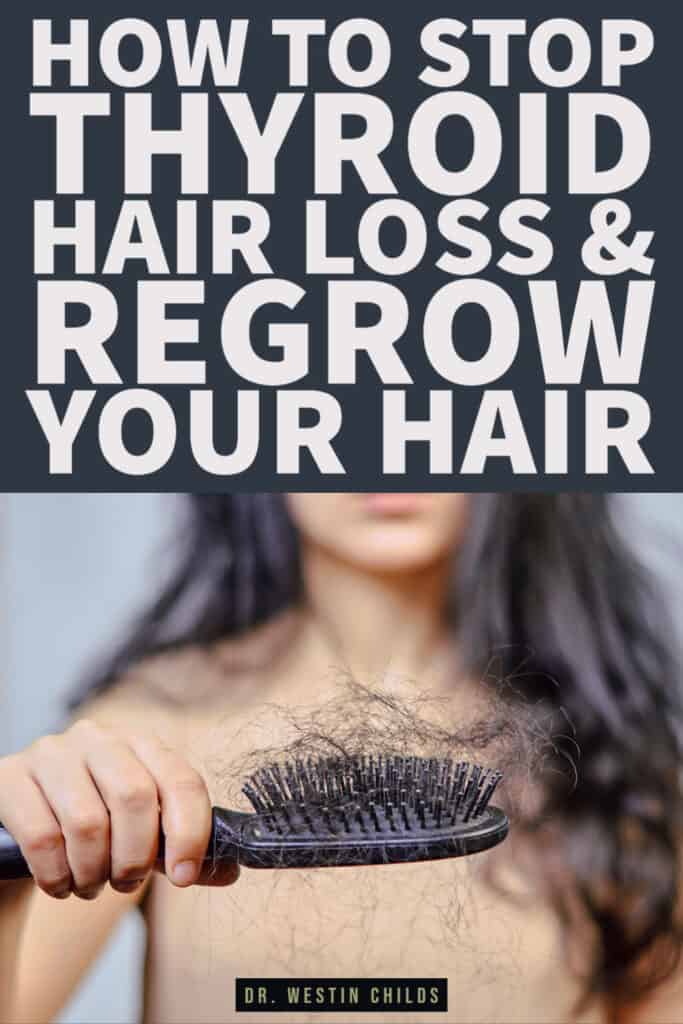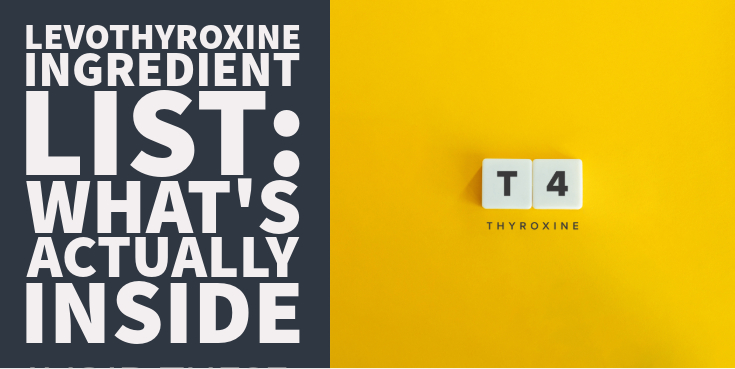Are you taking thyroid medication but still losing your hair?
Is your hair brittle, dry, or breaking?
All of these symptoms may result either directly from low thyroid or as a result of low thyroid function in your body.
What most patients don’t realize is that hair loss is multifactorial (meaning many things contribute to it) and that means that stopping hair loss requires a comprehensive approach.
Micronutrient deficiencies, high testosterone, high cortisol, low iron, and much more all contribute to hair loss in thyroid patients.
Find out what is causing your hair loss and how to fix it below:
Hair Loss and your Thyroid
Without a doubt, there is a very strong link between thyroid function and hair growth.
In fact, it has been shown (and many of you may be experiencing these symptoms right now) that low thyroid function is associated with all of the following changes:
- Dry and brittle hair
- Hair loss
- Reduced hair growth
- Hair breakage
- Excessive hair loss while showering
It turns out that your thyroid plays a critical role in both the development and maintenance of the hair follicle (1).
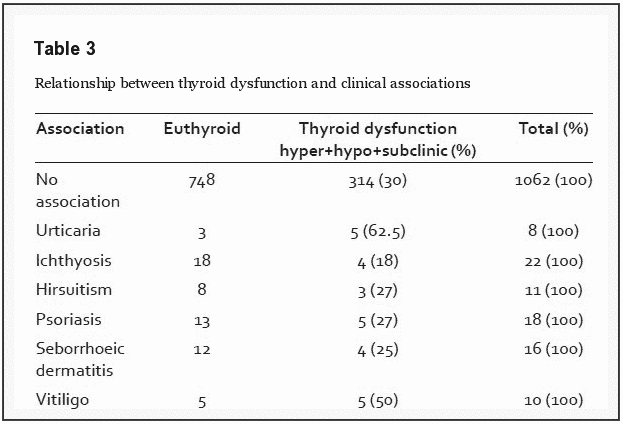
That means that low thyroid function can make your hair fall out and can slow down or completely stop hair regrowth.
But it doesn’t stop there…
To make matters worse low thyroid function promotes nutrient deficiencies that are required for proper hair growth.
We are going to talk more about how this happens and how to replace these nutrients, but by virtue of how thyroid hormone reduces stomach acid, it can also reduce the absorption of nutrients like iron and B12 (2) which are required for proper hair growth.
To complicate things even further thyroid hormone medications like levothyroxine can cause hair loss as a negative side effect to taking the medication.
So effectively you may be losing hair because your thyroid function is too low but taking thyroid medication also might be increasing your hair loss.
And don’t forget that hypothyroidism itself also depletes the micronutrients required for proper hair growth.
When you put all of these factors together it’s easy to see why finding the root cause of your hair loss can be difficult and why it takes a comprehensive approach.
- Bottom line: Hair loss in hypothyroid patients may occur from hypothyroidism itself, as a negative side effect of thyroid medication, or from the nutrient deficiencies caused by low thyroid hormone. Each of these must be treated to ensure proper hair growth.
DOWNLOAD FREE RESOURCES
Foods to Avoid if you Have Thyroid Problems:
I’ve found that these 10 foods cause the most problems for thyroid patients. Learn which foods you should avoid if you have thyroid disease of any type.
The Complete List of Thyroid Lab tests:
The list includes optimal ranges, normal ranges, and the complete list of tests you need to diagnose and manage thyroid disease correctly!
How to Regrow your Hair with Hypothyroidism:
While thyroid function is very important for regrowing your hair back it’s not the only (and in some cases not the most important) factor involved.
Often times hair loss in hypothyroid patients is a result of multiple factors.
This means that just assessing for one problem, taking one supplement, or making one change will not be as effective as trying multiple things at once.
This has to do with how thyroid hormone interacts with other hormones and nutrients in the body.
If you have hair loss and you aren’t sure if you have hypothyroidism then make sure to check out this post here for a complete list of symptoms related to your thyroid.
If you know you have hypothyroidism already and are experiencing hair loss then read on…
#1. Check your Thyroid Dosing & Medication
The first thing you should be evaluating is your thyroid function.
I’m assuming you already have a diagnosis of hypothyroidism by the time you read this.
That means you are most likely taking some form of thyroid medication.
And this is where things get a little bit tricky:
It turns out you need enough thyroid hormone (including T3) in your body and system to have proper hair growth.
T3 and both T4 prolong the duration of the hair growth cycle by blocking an inhibitory growth factor TGF-B2 (3).
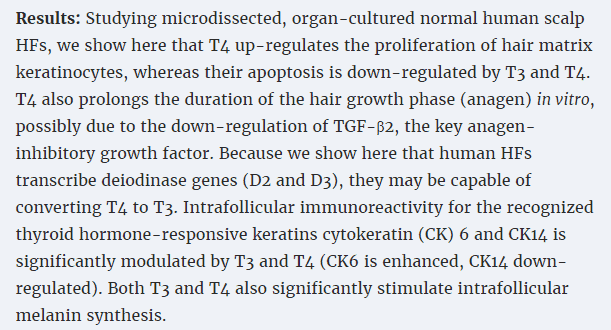
On the flip side – too much thyroid hormone can increase hair loss as well.
What this means for you is that you need to find the sweet spot where your body has enough thyroid hormone in the body (in the form of T3 thyroid hormone), but not enough to increase hair loss.
It is well known that hypothyroidism (meaning low thyroid function) causes hair loss, hair breakage, etc.
But it is also well known that one of the main symptoms of hyperthyroidism is hair loss as well.
So how do you know if you have “enough”?
Unfortunately, there is no magical number that your T4 or T3 levels should be in order for your hair to grow properly, but we can follow some guidelines.
First:
You need enough T3 in your body to promote hair growth.
For most patients that means taking T3 in some form.
You can get this T3 by taking natural desiccated thyroid or by adding liothyronine or Cytomel to your current dose of T3.

Most patients are being treated with T4-only thyroid medications like levothyroxine or Synthroid.
These medications rely on your body to convert T4 into T3, but this doesn’t always happen.
For this reason, many patients may actually need to add T3 to their current regimen to slow down their hair loss.
In some cases, levothyroxine and Synthroid may be enough but the dose simply isn’t high enough.
In these cases, you need to make sure that your dose is adequate and high enough.
You can find more info on how to dose levothyroxine here.
Second:
Don’t focus on your thyroid lab values, instead focus on your symptoms and how you are feeling.
Many patients (and providers) have a tendency to focus on TSH as an indicator that they have “enough” thyroid hormone in their body.
But so many patients walk around with a “normal” TSH but their hair is falling out and they are still fatigued.
In many cases, the TSH (as an isolated value) is not very predictive of tissue levels of thyroid hormone.
Studies have shown (4) that patients treated with thyroid medication to “euthyroid” TSH levels (meaning normal TSH levels) still show lower levels of T4 and T3 than controls who are not on thyroid medication.
Unfortunately, the free T3 and free T4 values mean more to your body than your TSH and it is these values that influence your hair growth.
Because of this, it’s not the best idea to base your dosing on TSH alone.
Instead focus on other factors like your symptoms, body temperature, and resting heart rate.
If your thyroid lab tests are “normal” but you are still having many of these symptoms (including hair loss), then your dose may not be sufficient.
Third:
This one gets a little tricky, but we need to talk about it…
Your medication may actually be making your hair loss worse.
What I mean by that is this:
One of the negative side effects of thyroid medication is hair loss.
This side effect is separate from hair loss related to high or low thyroid levels, it’s just a side effect of the medication itself.
Obviously, this can complicate the picture…
You may be thinking your hair loss is due to a low dose, when in reality it may be caused by your medication!
Below I will go over how each type of medication can cause hair loss and what to do about it:
Levothyroxine can cause hair loss

T4-only thyroid medications can cause hair loss as a negative side effect of taking the medication.
This can be as a side effect of overdose (5) (taking too much) but is also likely related to the fillers/dyes in the medication itself.
As you know levothyroxine is a T4-only thyroid medication (Synthroid, Levothyroxine, etc.).
T4 is important for hair growth, but T3 is as well.
Many providers try to increase T3 levels by giving patients T4-only thyroid medication, but this assumes that the patient has no issues with T4 to T3 conversion.
In cases where patients have problems converting T4 to T3, it’s possible to take too much T4 thyroid hormone which can lead to hair loss due to this build-up.

On the flip side, the inactive fillers and dyes in levothyroxine and other T4-only formulations likely contribute to hair loss as well.
If you are experiencing hair loss while taking Levothyroxine you have to figure out if it’s directly related to the medication itself or due to a low or high dose.
One relatively easy way to determine this is by switching your T4 medication.
Even switching from generic Levothyroxine to Tirosint may dramatically improve your hair loss.
Tirosint has the fewest inactive ingredients out of all T4-only thyroid medications which means that it is more highly absorbed (meaning you will get “more” of the thyroid medication).
In addition, Tirosint has 3 inactive ingredients.
By switching to Tirosint you can account for absorption issues and for adverse reactions to inactive fillers.
If this option doesn’t work then you may need to switch to NDT formulations (or T3 formulations).
Cytomel Can Cause Hair Loss
Compared to Levothyroxine, Cytomel/liothyronine is a T3-only thyroid medication.
T3 as a thyroid hormone is much more powerful than T4-only thyroid medication because T3 is directly active in your cells, whereas T4 has to be activated.
Some patients believe that adding T3 (or switching to T3) will dramatically reduce their symptoms of hypothyroidism, including their hair loss.
One side effect of Cytomel and Liothyronine is a dramatic but temporary increase in hair loss (6) in some patients while starting this medication.
Upon switching or adding T3 to their regimen this can cause some concern for many patients.
Fortunately this, side effect tends to be self-limited.
Meaning, it will go away within 2-4 months.
When switching to or adding T3 to your current thyroid regimen make sure you give it time because temporary hair loss is a known side effect of T3.

Obviously, this can cause some confusion for patients who may wrongly believe that their hair loss is a result of taking too much thyroid hormone or confuse them further.
If you fall into this category do not be alarmed, instead, give it some time – up to 2 to 4 months and the hair loss will likely subside.
In my experience, this side effect tends to occur about 20-30% of the time when, and it is a real cause of concern for many patients who are already self-conscious about their hair.
The mechanism of this hair loss is not understood, but in my opinion, it likely has to do with an increased demand for hair growth and insufficiency in local nutrients and other growth factors that aren’t ready for the increased demand.
NDT Can Cause Hair Loss
Natural desiccated thyroid like Nature-throid, Armour Thyroid, NP Thyroid, and WP thyroid can cause hair loss as well.
The mechanism behind hair loss in these medications is less understood than in other medications but is likely due to a reaction to the ingredients and the amount of T3 in these medications.
Most of the time the hair loss in these patients is usually temporary (but not always).
If you experience increased hair loss while switching to NDT formulations then you should consider this:
1) Make sure that you optimize your micronutrient status
In some cases, hair loss isn’t necessarily due to the medication itself, but instead due to the increased demand that the thyroid hormone places on the hair follicles.
By addressing micronutrient status (discussed more below) and by providing your body with the building blocks for hair growth, this hair loss will likely stop in 1-2 months.
2) Try switching to a different type of NDT
Occasionally patients simply need to switch to a different type of NDT medication.
For instance:
If you are noticing hair loss while taking Armour Thyroid, then consider switching to the same dose of WP thyroid or Nature-throid.
Remember that much like T4-only thyroid medications, each NDT medication contains different fillers.
This means that you may react poorly to one medication and better to another.
This switch is relatively easy to do and may stop hair loss.
In my experience, I have some patients who simply don’t tolerate certain types of NDT but by trying various combinations we can eventually get to the right type/dose of medication to halt hair loss.
3) Lastly, consider switching to T4 + T3 compounded medications
If the other options fail then you should consider switching to compounded formulations of T4 + T3 in similar doses to that of your NDT.
This will help you determine if your hair loss is due to your medication or if it’s due to some other factor (low dosage, etc.).
Hyperthyroidism Can Cause Hair Loss
Lastly, remember that taking too much thyroid medication can also cause hair loss.
This can confuse patients further because it is possible to take too much thyroid hormone and cause negative side effects that may mimic hypothyroidism.
For instance:
Taking too much thyroid hormone can lead to fatigue, anxiety, and worsening hair loss – all of which are symptoms of hypothyroidism.
Due to various factors, and our current treatment paradigm, it’s easy for patients to believe that they are under-dosed when in reality they may be taking too much thyroid hormone.
Just keep this in the back of your mind while assessing your hair loss.
#2. Check your Iron & Ferritin Status
One of the most critical nutrients (and often most overlooked) for hair growth is your iron status.
Iron is so important for hair growth that you can’t blame hair loss on your thyroid until you’ve increased your ferritin and other iron levels to a suitable level.
For reference, a ferritin level of at least 30 ng/mL (7) is required for proper hair growth.
Studies have shown that in women with systemic inflammation (evidenced by high levels of ESR/CRP) and other underlying hormone imbalances, ferritin levels lower than 30 ng/mL are strongly associated with hair loss.
And remember this:
Ferritin is a marker of the iron stores in your body, but your ferritin can be low while your iron levels are relatively “normal”.
What’s worse is that the low end of the reference range for ferritin is less than 10 ng/mL as evidenced in the example below:

You can see that the ferritin reference range is from 10 to 154 ng/mL meaning that you can range anywhere from 10 to 29 and still be considered “normal”.
Meanwhile, you may be experiencing diffuse hair loss or other symptoms of low ferritin.
Because of this, it’s important that you understand where your ferritin level needs to be if you are suffering from hair loss.
Another very important connection, as it relates to patients with hypothyroidism, is the connection between thyroid hormone and iron deficiency.
Low thyroid hormone causes iron deficiency due to decreased absorption in the GI tract.
This means that hypothyroid patients are in a situation that promotes iron deficiency.
This causes a double whammy:
Hair loss from hypothyroidism and now hair loss from low iron caused by low thyroid function.
For these reasons, iron is almost more important than your thyroid hormone when evaluating hair loss.
The symptoms of low iron also mimic the symptoms of hypothyroidism because ferritin is required for proper thyroid conversion and function.
Because iron is very much a “Goldilocks” type of nutrient, meaning you don’t want too much and you don’t want too little, you need to make sure you evaluate your serum levels before you supplement.
When supplementing with iron make sure that you are also being treated with thyroid hormone to ensure proper absorption.
Also make sure that you take any iron supplements AWAY from your thyroid medication, as iron may delay or inhibit its absorption.
For most patients that means taking iron at least 4 hours away from your thyroid hormone.
How to Use Iron
- Liquid iron: Start with 10 ml each day, do not exceed 20 ml per day (if you take more than 1 dose per day make sure to split it apart from one another and take at least 4 hours away from your thyroid medication)
- Iron capsules: Start with 1 capsule of iron and increase up to 3 per day as tolerated and based on your serum iron/ferritin levels (take at least 4 hours away from your thyroid medication)
Liquid iron is best if you have intestinal issues such as gas, bloating, diarrhea, or constipation, or if you have previously failed capsule forms of iron.
Iron capsules are best if you can’t tolerate liquid iron supplements (some patients have various symptoms when using liquid iron such as tooth pain or an intolerance to the taste/texture).
Remember:
Do not use iron unless you have checked your iron lab tests and confirmed that you actually need it.
#3. Check your Micronutrient status & Try these Hair Regrowth Supplements that actually work
Believe it or not, the role that micronutrients play in hair loss is not well understood and not well studied.
We know for sure that many micronutrients (8) are required in the production of hair growth, and therefore deficiencies in these nutrients likely lead to hair loss.
The research in these areas is somewhat limited so I have included below the list of the most powerful nutritional supplements, and ones that I have personally used and know work below.
We’ve already discussed the role that iron plays in hair growth but there are other micronutrients involved as well:
- Zinc (9) <— Zinc is required for hair growth and thyroid hormone is required for zinc absorption, zinc also improves T4 to T3 conversion
- Selenium (10) <— Selenium helps boost T4 to T3 conversion and may reduce inflammation in Hashimoto’s patients, it’s also involved in hair synthesis
- Biotin + Silica + Choline (11) <— Supplementing with Biotin in double-blind controlled trials shows an increase in the number of hair follicles, hair volume, and hair thickness
- L-Lysine (12) <— Supplementing with L-lysine in addition to iron can improve hair growth
- Vitamin B12 Shots (13) <— Vitamin B12 (along with normal hemoglobin) is required for optimal hair growth, hypothyroid patients are also at increased risk for developing B12 deficiency
Obviously, there are other factors involved in hair growth, but these micronutrients are commonly deficient, and replacing them often leads to significant improvement in hair growth.
Like iron, low thyroid sets up a state where many of these nutrients may not be absorbed.
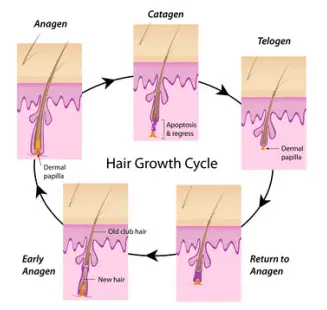
Couple that with the nutrient-depleted standard American diet, and you have a perfect setup for micronutrient deficiencies that lead to hair loss.
When you consider supplementing with these medications make sure that you also evaluate other major factors like your thyroid medication and your iron status.
Utilizing multiple therapies at once will likely lead you to the BEST results possible.
One of my favorite supplements to use is the combination of silica and biotin, which I find particularly helpful in thyroid patients.
Silicon is the third most abundant trace element in the human body and is necessary for collagen production.
It’s been suggested (and my experience confirms this), that silicon supplements help reduce hair loss and improve hair texture.
For this reason, I often suggest this combination to patients with hypothyroidism and hair loss.
How to use silicon for thyroid hair loss:
- Take 1-2 capsules of silicon each day. Silicon forms complexes which make absorption difficult so look for formulations that increase absorption such as choline-stabilized orthosilicic acid or MMST.
- Depending on your hair growth cycle and when you start supplementing, you should expect to see an improvement in your hair growth and hair loss within around 4-8 weeks.
Next up we have L-lysine.
Studies have shown that patients who don’t respond to iron alone show hair growth when L-lysine is added to their regimen (14).
For this reason, L-lysine makes the list because it is required for proper hair growth.
How to use L-lysine for thyroid hair loss:
- Use 1,500mg per day (3 capsules) for best results in combination with iron, but away from thyroid hormone
Another nutrient required for hair growth is selenium which also has an impact on thyroid function.
Selenium helps boost T4 to T3 conversion (15), thereby increasing the amount of circulating T3 in your body.
At the same time, it has also been shown to help balance immunity and reduce TPO antibodies in patients with Hashimoto’s thyroiditis.
For these reasons, patients with Hashimoto’s suffering from thyroid hair loss should consider selenium supplementation.
How to use selenium for thyroid hair loss:
- Aim to get an average of 75 to 150mcg of selenium each day. Avoid using doses higher than 400-600mcg of selenium each day as this may make hair loss worse. You can use a supplement like this one to get you the right dose and the right form of selenium.
- For best results, use selenium in combination with other nutrients such as zinc, iron (if necessary), and silicon.
We can’t have a conversation about selenium without mentioning zinc.
Like selenium, zinc helps promote T4 to T3 conversion, acts as an anti-inflammatory agent, and can boost immune function.
What’s more interesting is that thyroid hormone is required for proper zinc absorption.
This means that hypothyroid states can deplete zinc levels and supplementation with zinc isn’t optimal unless you are also supplementing with thyroid hormone.
Zinc also plays an important role in hair growth and replacing zinc has been shown to increase hair volume (16).
For these reasons, using zinc is a great idea if you have thyroid hair loss.
Here’s how:
- Aim to get 8 to 15mg of zinc into your body each time you take a zinc supplement. The following forms are best: zinc chelate, zinc monomethionine, zinc gluconate, zinc acetate, and zinc citrate. If you are taking a form of zinc not listed here then it’s not the best form for your thyroid or for your hair. You can get the right formulation of zinc at the right dose in a supplement like this one.
The last nutrient you will want to consider is vitamin B12.
It’s currently estimated that as many as 40% of hypothyroid patients are B12 deficient or at least have suboptimal B12 levels.
Like the other nutrients listed above, thyroid hormone is required for optimal B12 absorption which is probably why so many low thyroid patients are deficient.
This connection may explain why so many hypothyroid patients experience low energy and low B12 levels despite taking oral formulations of B12.
Because hypothyroid states can limit B12 absorption (even sublingual forms) I recommend highly absorbable and activated forms of B12 and other B complex vitamins.
You may even want to consider using B12 shots to bypass the intestinal tract if this option is available to you.
In terms of B12 levels, you will want to aim for a serum B12 level of at least 700 ng/L.
How to supplement with vitamin B12 & other B complex vitamins for thyroid hair loss:
- Take 1-2 Capsules per day of methylcobalamin and activated B vitamins daily on an empty stomach. Avoid B12 formulations that are not preactivated or premethylated such as cyanocobalamin. You can use B12 by itself or in combination with other B vitamins.
- If they are available to you, you may want to consider methylcobalamin B12 shots.
#4. Manage your Testosterone & Androgen Levels
Your thyroid isn’t the only hormone in your body that contributes to hair loss.
The levels of testosterone (and androgens) in your body also play an important role in managing hair loss (especially male-patterned baldness in women).
High levels of androgens (like testosterone and dihydrotestosterone) sit on and activate the androgen receptors on your hair follicles.
The activation of these receptors results in male-patterned baldness, the same pattern of baldness that happens in men!
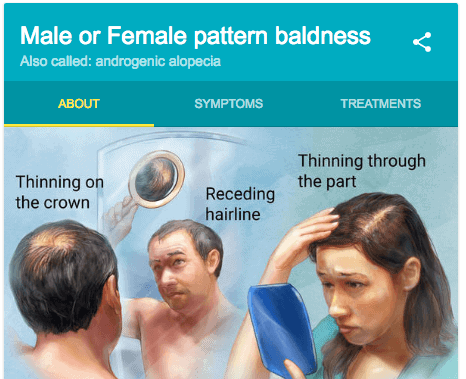
The mechanism by which testosterone and other androgens cause hair loss is different from the way that the thyroid causes hair loss, but both can absolutely be present at the same time.
So if you have hair loss and a known diagnosis of PCOS or simply high testosterone levels in your labs, then this hormone imbalance may certainly be playing a role in your hair loss as well.
There are at least 6 causes of high testosterone and I’ve written about them extensively in this post, but I will include them here for you as well:
- Insulin resistance (17) <— this is a BIG one and one of the most common reasons
- Estrogen and progesterone imbalances (estrogen dominance)
- Lack of exercise
- Adrenal problems that result in high cortisol and high DHEA levels
- High leptin levels or leptin resistance
- Weight gain and increased adiposity by itself
By far the most common cause of high testosterone and androgen levels that lead to hair loss in women is a result of high insulin levels.
This connection is well established in the literature (18) and is part of the PCOS spectrum.
Women who maintain high insulin levels also typically have high testosterone, low progesterone, high estrogen, and low thyroid function.
As I’ve mentioned previously these hormone imbalances tend to accompany one another, so having just one is very unlikely.
For this reason, it’s very important that you have your free and total testosterone levels checked in addition to your DHEA and cortisol levels checked.
This will give you an idea of your androgen status and can help determine if your hair loss is related to high androgen levels.
What’s interesting is that low thyroid function results in high insulin (19) levels, so having hypothyroidism really sets the stage for high testosterone in many women.
This means that part of your treatment should be on getting on the right type and dose of thyroid hormone.
The treatment for high testosterone varies based on what caused it in the first place and you can find the treatment for each cause in the post I listed above.
For this post, I will focus primarily on supplements that are designed to help your body metabolize testosterone and get rid of it from your body.
One such supplement we have already discussed:
Zinc.
Zinc is an inhibitor of the enzyme 5 alpha-reductase, and it is this enzyme that turns your testosterone into DHT.
So by reducing the activity of this enzyme, you can effectively reduce the amount of DHT circulating through your body, and DHT is approximately 5x more potent than testosterone itself.
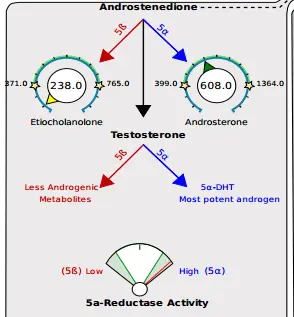
This means that DHT should be your primary target when helping promote hair growth.
Another very potent inhibitor of 5 alpha-reductase is saw palmetto (20).
The combination of Saw palmetto + Zinc at high enough dosages can dramatically improve hair growth and reduce the symptoms of high testosterone in both women and men.
You already know how to supplement with zinc (it’s the same as above), so let’s focus on saw palmetto.
Studies have shown that 4 weeks of supplementing with saw palmetto (21) can improve hair growth, but note that most patients will need to continue to use saw palmetto beyond 4 weeks for best results.
Supplements that help block DHT and lower testosterone levels to help with hair growth:
- Saw palmetto – Take 2 capsules per day for at least 4 weeks for best results
- Zinc – Take 2 capsules per day (will also help promote hair growth and improve thyroid function)
- Bottom line: For best results make sure that you focus on the underlying CAUSE of high testosterone/androgens in your body in addition to supplementing. Please see this post for more information on how to do that.
#5. Maintain proper estrogen/progesterone balance
Estrogen and progesterone also play a role in hair growth and hair loss.
Dysregulation (or an imbalance) in the estrogen/progesterone ratio can contribute to hair loss.

It has been shown that changes in estrogen levels (22) contribute to hair loss in many women.
Intuitively we know that this is true because we see it happen with women who go through menopause and with women who are pregnant.
Menopause may result in changes to hair volume and texture (23) as well as the post-partum state.
What’s important here is to focus on the connection between thyroid hormone and estrogen/progesterone levels.
Low thyroid hormone results in low progesterone levels which may alter and change the relative concentration of estrogen: progesterone.
This change is enough to cause issues with hair growth by itself.
In many cases, simply getting on the right type and dose of thyroid medication it’s enough to dramatically improve this ratio and reduce estrogen dominance.
Much like testosterone, insulin also plays a role in the estrogen/progesterone balance and so some women may need to treat insulin resistance to balance their estrogen levels.
#6. Manage your stress & Cortisol levels
We can’t talk about hair loss without at least mentioning cortisol and stress levels.
You know by now that managing your stress is very important for managing your thyroid function, but perhaps you didn’t know that cortisol extends beyond your thyroid and into your hair.
Studies have shown that high cortisol levels alter the function and cyclic regulation of hair follicles (24).
That means that high cortisol levels could be contributing to your hair loss.
You know that cortisol is your stress hormone, which means that when you are stressed out your body will secrete more cortisol.
Constant stress results in changes at the receptor level (25) and may actually alter serum cortisol levels (stress can both lower or raise cortisol levels).
Your thyroid fits into this equation because thyroid hormone is involved directly with cortisol.
A high TSH has been associated with high cortisol levels (26) (and you know a high TSH is a marker of low thyroid function).
This means that hypothyroidism makes your body less resilient to stressful situations and may explain why so many hypothyroid patients also have issues with cortisol dysregulation.
To help your body regulate stress you can consider using adrenal adaptogens which can actually help lower cortisol levels, and lower adrenal androgens and have even been shown to improve hair growth in studies (27).
The best adaptogen to use for this problem is ashwagandha:
How to use ashwagandha to support adrenal health:
- There are several types of ashwagandha available and the dosing varies based on whether or not you are taking it in conjunction with other adaptogens or adrenal glandulars. The two best types for thyroid hair loss include KSM-66 and Sensoril (root and leaf extract). I’ve found success with both formulations.
#7. Consider Over-The-Counter Medications
Lastly, there is an over-the-counter medication that you can consider using to stop thyroid-related hair loss.
Minoxidil is a topical over-the-counter medication that promotes hair growth and stops hair loss by altering potassium channels and increasing local blood flow and oxygenation (28).
This effect likely results in increased nutrient delivery to hair follicles which then promotes hair growth.
It also prolongs the growth phase of the hair follicle which helps reduce hair loss over a long period of time.
While taking minoxidil will not be a long-term solution, it does have value in certain patients because it can effectively (and dramatically) stop hair loss in its tracks.
Studies have shown that topical minoxidil in both men and women (29) has been shown to improve hair growth if used long-term.
Whenever possible I always recommend going after the root cause and treating that problem, but I also recognize the importance of immediate (or quick) resolution of symptoms.
Many of the therapies we’ve listed above take weeks to months to set in, and while these therapies are building up it may be a good idea to halt the current hair loss.
You may also consider using minoxidil if your hair loss is causing significant social stress or a change in your self-confidence.
I don’t necessarily recommend the long-term use of minoxidil but I do think it has value in certain situations.
Just proceed with caution with the understanding that once you stop taking it, your hair will revert back to whatever state it was when you first started using it.
In terms of dosing, there is some debate as to whether 2% or 5% is better for women, but studies have shown that both are effective.
So in that regard, it probably doesn’t matter which one you use but I would tend to err on the side of less (not more).
Who should use minoxidil?
- People who are self-conscious about their hair loss and who need immediate results.
- People with high levels of testosterone (both men and women) who haven’t been able to lower it through lifestyle changes.
- People who have tried other oral thyroid hair growth supplements without benefit.
How to use minoxidil:
- Apply the topical solution to your scalp (or areas where your hair is thin, remember that this works topically so you must put it where you have problems).
- Make sure to wash your hands afterward so you don’t stain your clothes (and be careful because the liquid can run down your head).
- Allow enough time for it to dry (usually between 2-4 hours) before shampooing your hair or applying hair spray, gel, or other hair care products.
- Apply at least once per day but preferably twice per day.
Generic versions of minoxidil can be purchased online and in grocery stores.
- Bottom line: Minoxidil can help stop hair loss immediately while you wait for other therapies to start working. This medication isn’t necessarily a long-term solution but it can help halt hair loss quickly while new hair grows back.
Dealing with Hair Loss Related to Hashimoto’s & Thyroiditis Hair Loss
What if you have hair loss related to Hashimoto’s or thyroiditis?
Does this change how you deal with or treat your issue?
The answer is… not really, and here’s why.
It turns out that most patients in the United States who have hypothyroidism suffer from this condition as a result of Hashimoto’s.
In fact, it is estimated that up to 90% of patients with hypothyroidism have Hashimoto’s thyroiditis as the underlying cause.
So, patients with thyroiditis have all of the usual problems that most hypothyroid patients have, plus they have a few extra from the autoimmune and genetic aspects of Hashimoto’s which can complicate the hair loss picture.
What does that mean for you?
It means if you have Hashimoto’s you still need to look at all of the “usual suspects” including:
- Iron and ferritin levels
- Thyroid medication side effects
- Thyroid medication dosage and type of thyroid medication
- Status of other hair regrowth nutrients
- Status of your sex hormones (such as excess testosterone and low estrogen)
- PLUS: Genetic causes of hair loss (30)
- PLUS: Sensitivity to hair and makeup products (31)
Those who have Hashimoto’s will know that they are often very sensitive to inactive ingredients which include dyes and fillers in all products ranging from supplements to shampoos and conditioners.
In addition to all of the recommendations above, you will want to make sure that you also ditch low-quality hair products which you may be reacting to.
These products can damage what little hair you have left and some of the chemicals may be absorbed transdermally (through the skin).
And, lastly, you may need to look into genetic causes of hair loss which may be caused due to your genes (you may not have control over these).
I’ve seen patients who undergo all of the therapies and recommendations listed in this article with little to no success.
In many cases, probably around 95-98%, you should find SOME improvement (the amount may vary based on the individual), which means it’s rare to not experience any relief.
But, there are genetic causes of hair loss that seem to be more prevalent in those who suffer from autoimmune disease.
You’ll know if you fit into this category because your mom, sister, or grandmother may suffer from the exact same symptoms as you.
Currently, we do not have great treatment options available for those who have genetic-related hair loss (aside from those listed in this article).
FAQ + Other Thyroid & Hair Loss Questions
If your questions weren’t answered in the information above I’ve also included several frequently asked questions below:
Can Thyroid Problems Cause Hair Loss?
Yes, both low thyroid and high thyroid levels can contribute to hair loss.
Hair loss is a documented and well-known side effect of both hyperthyroidism and hypothyroidism.
Can Synthroid Cause Hair Loss?
Yes, one of the side effects of Synthroid is hair loss.
This may be due to the medication itself (including inactive fillers and dyes) or due to your dose itself.
Both high and low dosages of levothyroxine can contribute to hair loss.
Will Taking Levothyroxine Make my Hair Grow?
If your hair loss is due to hypothyroidism then taking Levothyroxine will improve your hair.
Many times the state of hypothyroidism results in a cascade of hormone imbalances and nutrient deficiencies that all lead to hair loss.
This means that you must address all of these problems for the best results.
Does Cytomel Cause Hair Loss?
Yes, Cytomel and Liothyronine can both cause temporary hair loss that is usually self-limiting within 2-4 months.
In most cases, the hair loss side effect of taking Cytomel will simply fade with time.
Does Armour Thyroid (or other forms of natural desiccated thyroid) Cause Hair Loss?
Yes, NDT including Armour Thyroid, Nature-throid, and WP Thyroid can all cause hair loss.
Does Hyperthyroidism Cause Hair Loss?
Yes, too much thyroid hormone in your body can also contribute to hair loss.
This can come from taking too much thyroid hormone as well.
Will Hypothyroidism Cause my Eyebrows to Fall Out?
Yes, one of the main symptoms of hypothyroidism is hair loss in the lateral 1/3 of the eyebrow area.
Taking thyroid hormone (in high enough dosages) should cause this hair to regrow relatively quickly.
Will Taking Thyroid Medication Help my Hair Grow?
Yes, but most patients do better while taking some form of T3 thyroid hormone.
Some patients will experience hair growth on Levothyroxine, but many patients continue to have hair loss while taking this medication.
Is it a good idea to Microblade my eyebrows if I Have Thyroid Problems?
As you may have noticed it’s normal for patients to lose the lateral 1/3 of their eyebrows as a result of hypothyroidism.
In fact, this symptom is classic for thyroid patients.
While you can grow back this hair (at a slow rate) with many of the therapies listed above it’s also becoming more and more common to use a procedure known as microblading.
Microblading is the process of applying semi-permanent pigment to your eyebrows to bring them back to their normal shape.
I do think this is a process worth considering if you have thyroid issues and can be used to boost self-confidence (if that is an issue for you) while you undergo the recommendations above.
The microblading process is only temporary but may be beneficial in some cases.
You can learn more about the process and see before and after pictures here.
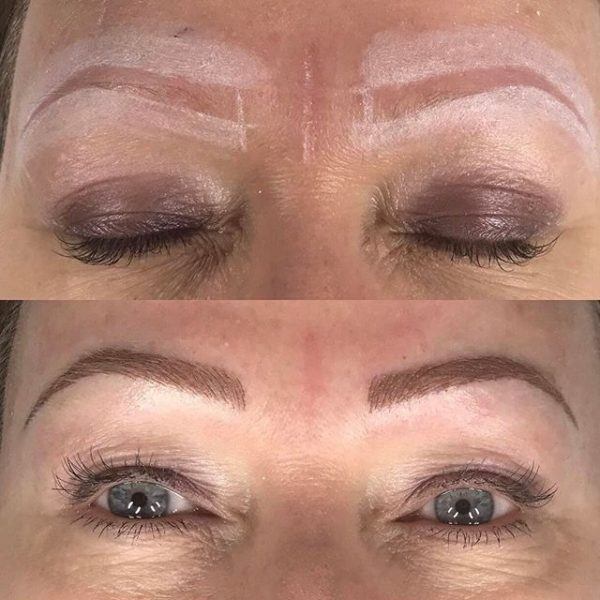
How Long Does it Take Hair to Grow Back?
Growing your hair back takes time, on the order of 4-6 months.
While making changes it’s often better to assess how much hair loss you have, instead of how fast your hair is growing back.
You will notice less hair loss while making changes long before you notice your hair growing back.
So while evaluating changes you make, focus on how much hair you are losing instead of if it is growing back.
Now it’s your turn:
Are you experiencing hair loss with hypothyroidism?
Has changing your medication slowed down your hair loss?
Why or why not?
Leave your comment below!
